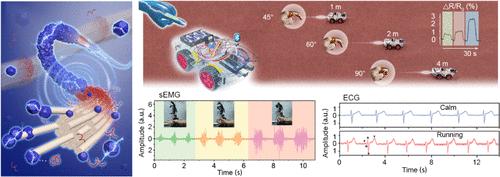Myelin Sheath-Inspired Hydrogel Electrode for Artificial Skin and Physiological Monitoring
IF 15.8
1区 材料科学
Q1 CHEMISTRY, MULTIDISCIPLINARY
引用次数: 0
Abstract
Significant advancements in hydrogel-based epidermal electrodes have been made in recent years. However, inherent limitations, such as adaptability, adhesion, and conductivity, have presented challenges, thereby limiting the sensitivity, signal-to-noise ratio (SNR), and stability of the physiological-electrode interface. In this study, we propose the concept of myelin sheath-inspired hydrogel epidermal electronics by incorporating numerous interpenetrating core–sheath-structured conductive nanofibers within a physically cross-linked polyelectrolyte network. Poly(3,4-ethylenedioxythiophene)-coated sulfonated cellulose nanofibers (PEDOT:SCNFs) are synthesized through a simple solvent-catalyzed sulfonation process, followed by oxidative self-polymerization and ionic liquid (IL) shielding steps, achieving a low electrochemical impedance of 42 Ω. The physical associations within the composite hydrogel network include complexation, electrostatic forces, hydrogen bonding, π–π stacking, hydrophobic interaction, and weak entanglements. These properties confer the hydrogel with high stretchability (770%), superconformability, self-adhesion (28 kPa on pigskin), and self-healing capabilities. By simulating the saltatory propagation effect of the nodes of Ranvier in the nervous system, the biomimetic hydrogel establishes high-fidelity epidermal electronic interfaces, offering benefits such as low interfacial contact impedance, significantly increased SNR (30 dB), as well as large-scale sensor array integration. The advanced biomimetic hydrogel holds tremendous potential for applications in electronic skin (e-skin), human-machine interfaces (HMIs), and healthcare assessment devices.

用于人造皮肤和生理监测的髓鞘激发型水凝胶电极
近年来,基于水凝胶的表皮电极取得了重大进展。然而,其固有的局限性(如适应性、粘附性和导电性)带来了挑战,从而限制了生理电极界面的灵敏度、信噪比(SNR)和稳定性。在这项研究中,我们提出了受髓鞘启发的水凝胶表皮电子学的概念,即在物理交联的聚电解质网络中加入大量相互渗透的核鞘结构导电纳米纤维。聚(3,4-亚乙二氧基噻吩)包覆磺化纤维素纳米纤维(PEDOT:SCNFs)是通过简单的溶剂催化磺化过程合成的,随后经过氧化自聚合和离子液体(IL)屏蔽步骤,实现了 42 Ω 的低电化学阻抗。这些特性使水凝胶具有高拉伸性(770%)、超塑性、自粘性(在猪皮上为 28 kPa)和自愈合能力。通过模拟神经系统中兰维耶节点的盐传效应,仿生水凝胶建立了高保真表皮电子界面,具有界面接触阻抗低、信噪比显著提高(30 dB)以及大规模传感器阵列集成等优点。这种先进的仿生物水凝胶在电子皮肤(e-skin)、人机界面(HMI)和医疗保健评估设备等方面的应用潜力巨大。
本文章由计算机程序翻译,如有差异,请以英文原文为准。
求助全文
约1分钟内获得全文
求助全文
来源期刊

ACS Nano
工程技术-材料科学:综合
CiteScore
26.00
自引率
4.10%
发文量
1627
审稿时长
1.7 months
期刊介绍:
ACS Nano, published monthly, serves as an international forum for comprehensive articles on nanoscience and nanotechnology research at the intersections of chemistry, biology, materials science, physics, and engineering. The journal fosters communication among scientists in these communities, facilitating collaboration, new research opportunities, and advancements through discoveries. ACS Nano covers synthesis, assembly, characterization, theory, and simulation of nanostructures, nanobiotechnology, nanofabrication, methods and tools for nanoscience and nanotechnology, and self- and directed-assembly. Alongside original research articles, it offers thorough reviews, perspectives on cutting-edge research, and discussions envisioning the future of nanoscience and nanotechnology.
 求助内容:
求助内容: 应助结果提醒方式:
应助结果提醒方式:


